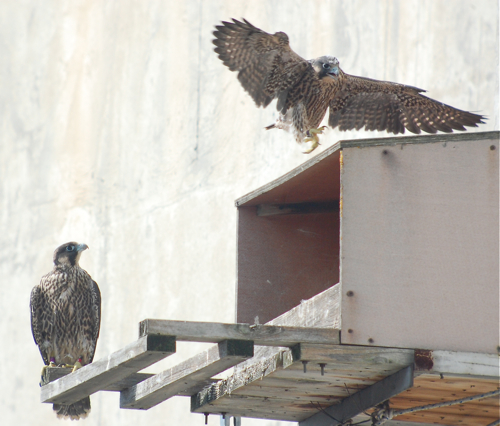 As part of my duties as a park ranger, we go out and rove in the park. Basically, we tote around a back pack with park info and you're on hand to answer questions--it's fun, it's a bit like improv. I like to take my scope for birding of course, but it gives me a chance to explore more areas of the park that I otherwise wouldn't visit. One is Lock and Dam 1. On Friday, we did a canoe paddle through the lock (you really haven't experienced the Mississippi until you've taken a canoe or kayak through a lock and dam--to be tiny in something so big is amazing). It was fun Saturday morning to look down on it knowing the day before I had been right in it.
As part of my duties as a park ranger, we go out and rove in the park. Basically, we tote around a back pack with park info and you're on hand to answer questions--it's fun, it's a bit like improv. I like to take my scope for birding of course, but it gives me a chance to explore more areas of the park that I otherwise wouldn't visit. One is Lock and Dam 1. On Friday, we did a canoe paddle through the lock (you really haven't experienced the Mississippi until you've taken a canoe or kayak through a lock and dam--to be tiny in something so big is amazing). It was fun Saturday morning to look down on it knowing the day before I had been right in it.

I was curious to be back on Saturday to see the peregrine chicks. Last week, they were a lot fluffier! On Friday as we canoed past, one was already out of the box, flapping around on a nearby ledge under the watchful eye of the adults. We had that big storm on Friday night and I wondered how the first fledger from the box fared. When I arrived, two were still visible on the nest box perches, practicing their flapping skills. I scanned and couldn't find the third one. I wasn't too worried, I figured it was perched nearby and when the adults arrived with the food, I would hear it begging.
 This is the view from the deck of the Lock and Dam 1 visitor center. You can see the peregrine nest box on the far left on the wall (note the box below the brick building). As I watched this, I noticed some flapping behind the big pipe on the right...
This is the view from the deck of the Lock and Dam 1 visitor center. You can see the peregrine nest box on the far left on the wall (note the box below the brick building). As I watched this, I noticed some flapping behind the big pipe on the right...

The bird out of the box did survive the storm! Heck of a first night out of the nest box--2 storms with heavy rain and the only refuge is a pipe.
 The other two continued to practice. The one on top of the box almost seemed like it was really going to get completely off the box, but stayed and screamed impatiently for one of the adults to feed it. The adults flew in once or twice with food, but no drop offs were made in the box. They want the young out of the nest so they can learn to fly. The chicks want to be fed and eventually, they will put two and two together. When the chicks are hungry enough, they will fly out towards the adults with the food.
The other two continued to practice. The one on top of the box almost seemed like it was really going to get completely off the box, but stayed and screamed impatiently for one of the adults to feed it. The adults flew in once or twice with food, but no drop offs were made in the box. They want the young out of the nest so they can learn to fly. The chicks want to be fed and eventually, they will put two and two together. When the chicks are hungry enough, they will fly out towards the adults with the food.

I checked on the peregrine fledgling behind the pipe and noticed that it was laying down and they eyes were part way closed. I thought it was odd, but chicks lay down when they sleep, adults remain upright, sleeping on one foot while the head is turned around and tucked under a wing. I wondered if this bird was exhausted and not used to sleeping while standing yet.

If you think about how quickly a bird grow they have to work out how their bodies move and function relatively quickly. You will often see young birds like the immature above, just letting its wings hang to the side after flapping--those things are heavy and they aren't quite used to using those muscles just yet.

You'll see young birds in all kinds of weird positions as they work out their bodies (what's that bird doing, checking for the time on her Swatch?)--imagine going from super soft fluff to hard pin feathers growing in over every inch of your body in about two weeks. We think teething makes babies cranky. Feather shafts poking all over the skin has to be about as fun as sandpaper underwear on a bad sunburn.

When the peregrine nodded its head down, I though I would call my buddy Avian Images just to be on the safe side. She works at The Raptor Center and goes to the bandings, I thought she'd have an idea. As soon as I heard her cell ring...

In flew one of the adult peregrines and this bird sprang upright to beg for food--it was fine, just sleeping like a young bird instead of an adult. Whew.

And peregrines weren't the only cool thing--I found a huge turtle out of the water. I know that it is a softshell turtle, but I'm not sure which type. Someone on Twitter thought it might be a spiny softshell turtle which is possible in Minnesota (as is the smooth softshell). But many of the photos for spiny softshell show a light colored turtle and this is a very dark one. Whatever kind of turtle, it was huge with a pointy nose.
